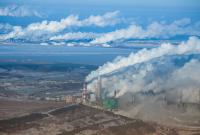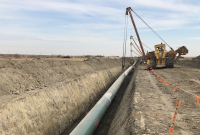Support strong Canadian climate journalism for 2025
Jason Kenney’s election victory speech played to the hurt feelings of Albertans. He said Alberta is captive to the U.S. market because foreign interests have landlocked Alberta oil. He said investment that has fled Canada is “fueling an unprecedented oil boom south of the border.” “In other words,” Kenney said, “we’ve been had.”
Albertans have been had. But it isn’t by special interests outside this country. It’s by Canadian politicians of all stripes who continue to sell a myth, a myth that the reason the oilsands have stopped seeing major new investment is that we don’t have enough pipelines.
What is odd about this myth is that most major players, no matter their stance on whether pipelines projects should proceed or not, want the public to believe it. Whether it’s Alberta’s incoming new premier Kenney, Prime Minister Justin Trudeau, the Canadian Association of Petroleum Producers (CAPP) or environmental activists 350.org, all tell you that a lack of pipelines is holding back oilsands investment. The truth is that is not what is holding oilsands investment back.
No. It’s that other thing Kenney mentioned: an unprecedented oil boom south of the border. Fracked U.S. oil is attracting the capital. And that is because it is a much better resource to exploit. A review of investment trends in oilsands and fracked oil so far this century explains this.
Bitumen from the oilsands is difficult to produce and process and yields a lot of low value product. On top of that, moving bitumen through pipelines requires expensive light gasoline blended in. Projects to produce bitumen require a huge amount of capital with a long payback and are located a long way from markets in an expensive place to build things with a brutal environment in the winter. Not exactly the ideal crude oil deposit to exploit.
But the thing about the oilsands is that they are massive and we know where they are. In the 2000s the world was thought to be running out of conventional crude and this was reflected in the price of crude as it ramped up from $20 at the start of this century to over $100. It made sense to turn to the oilsands. Investment doubled from $13 billion in 2000 to over $25 billion per year by 2005 and grew from there, until it didn’t.
Oilsands investment declined from a peak of $34 billion in 2014 to $11 billion estimated in 2018. What then stopped the boom?
Fracking unlocked natural gas and oil
Something big started happening in the United States in mid 2011. Fracking techniques that had recently unlocked natural gas deposits were widely applied in areas of known light crude reserves that conventional techniques couldn’t tap. As a result areas like the Bakken in North Dakota and the Permian Basin in Texas saw steep increases in production due to the use of fracking technology.
U.S. crude oil production in July 2011 was 5.6 million barrels per day (MBD). By January 2015 it was 9.3 MBD. By October of last year production was up to 12 MBD and counting.
From 2011 the increase in U.S. oil production has been four times the Canadian growth in the same period. While investment in the oilsands has been dropping off investment in U.S. oil production has continued growing. The United States in now the largest oil producer in the world.
It isn’t lack of pipelines holding back the oilsands; it’s the fact that it isn’t as attractive to invest in oilsands as in U.S. fracked oil. If industry had known how to frack for oil back in the year 2000 that big surge in oilsands investment never would have happened.
Since 2013 no major new oilsands project received a Final Investment Decision (FID) until late last year when Imperial Oil announced it was moving forward with its $2.5 billion Aspen project. That is a pittance relative to a $20 billion investment a few years ago in Imperial Oil’s Athabasca oilsands operation at Kearl Lake, Alta.
Why have no new projects moved forward during that time? Discounts on diluted bitumen were decent from 2014 through 2017 because there was pipeline capacity. Pipelines such as Enbridge Line 3 were expected to be coming; delays weren’t known then. So why no investments announced?
Because industry would rather spend money on quick payout, high quality oil closer to major markets. Can you blame them?
Canadian oil shouldn’t be sold at fire sale prices
Kenney said a lot of other things playing to the crowd. What is true is Alberta and Canada need more pipeline for the production coming from the oilsands investment whose growth has wound down. We shouldn’t be selling at fire sale prices.
But we don’t need all the pipelines under consideration. The combination of Enbridge Line 3, Trans Mountain Expansion and Keystone XL adds close to two million barrels per day (MBD) in pipeline capacity, almost twice as much as CAPP’s forecasted growth in production by 2030. That’s a forecast where industry assumes pipelines are available.
On top of those pipeline projects, Enbridge has identified other opportunities using existing lines of up to another half million barrels per day. So it will be solved. It’s taking time but pipelines do encroach on other people’s property and bring risks, so they need to be considered carefully, frustrating as that is to producers and governments.
More pipelines than required is a waste of capital, an inefficient drag on a struggling industry. That’s because pipeline owners don’t take the risk; pipelines have regulated returns and the new lines have contracts where the oil producers commit to paying for a pipeline whether or not they have crude to ship.
Canadians, especially Albertans, are being played. A good example is Kenney’s crusade for Energy East, a pipeline from Alberta to New Brunswick via Quebec. The economics don’t exist. And the Quebec government doesn’t want it. There isn’t enough new crude to fill such a large line and the refinery hardware in Eastern Canada for diluted bitumen is close to non-existent. Still, Kenney and his base love the idea. Economic reality is not a problem for them.
The oilsands golden years lasted about a decade, and they will never come back. While we need a couple of pipeline projects to proceed to get reasonable prices for our oil, all the shouting is just a distraction. It is time to position the Canadian oil sector for slow growth and environmental sense. That’s what real leaders who care about the future would focus on.







Comments
I cannot understand how a lack of pipeline capacity reduces the price of diluted bitumen.
If there's restricted supply, you'd think a product would be more scarce, therefore more costly.
I still don't get it? Can anyone explain?
Sure Walter, good question. There isn't a restricted supply of crude, there is too much. In the Gulf Coast where those last barrels are headed they can get crude from anywhere in the world so the lack of Canadian pipeline space has almost no influence there. Edmonton price = Gulf Coast price - transportation cost from Edmonton to the Gulf Coast. Rail is roughly twice as expensive as pipeline so that means a lower price in Edmonton if rail is required . Hope that helps.
At the moment, the likelihood of having too many pipelines is remote. It is unquestionably the case that prices received for Alberta oil are depressed due to high transportation costs, and oil-by-rail is competing for capacity and driving up prices for shipment of agricultural products. The demand is there and, in particular, gulf coast refineries have the capacity to utilize Canadian heavy oil if it could be transported economically. This can only be remedied by completing at least some of the proposed pipelines. The current situation is causing significant economic damage to Alberta and to Canada.
Hi John, Ross,
Can either of you quote the difference in production cost between a fracked barrel and bitumen barrel? I don't know but I suspect that that difference greatly outstrips any rail/pipe difference in transportation costs?
John,
As many folks have been saying - the world is currently awash in cheap-to-produce crude. When will that inconvenient truth finally sink in? The only time that the world price goes up is when the cartels throttle their production. It's been like that .. forever? Mr. Kenney's best play may be to wine-and-dine the OPEC leaders that control the taps, but good luck with that: it seems if anything their recent preference has been to keep prices down to discourage competition. And why not? That's their perogative. Wouldn't you say Alberta has been on the end of the OPEC yo-yo string for long enough? The best time to save and diversify the Alberta economy was 30 years ago, the second best time to start is today.
Hi Andrew, this article quotes breakeven production costs as requiring WTI at $60/B for new SAGD projects. www reuters com/article/us-canada-oilsands-economics-analysis/canadas-oil-sands-survive-but-cant-thrive-in-a-50-oil-world-idUSKBN1CN0FD. Mining projects are not expected to come back at all, requiring higher prices.
this one suggests that fracking requires something less than $50/B. www oilsandsmagazine com/market-insights/impact-of-us-crude-production-on-oil-prices-how-us-shale-boom-disrupted-world-oil-markets
But just looking at a WTI price is too simplistic because of two factors. One bitumen is much heavier than fracked crude so is influenced by what is going on in international heavy markets. And there is about to be a huge shift with marine fuel oil sulphur specs, which impacts millions of a barrels a day of the heaviest material in the world. Secondly if the world does de-carbonize a fracked crude investment gets most if its cashflow in the first three years because of the nature of fracking and is therefore less risky. Whereas bitumen projects require long lives to full return the big capital investment, they get steady long term production but that's risky because of the uncertainty of crude markets ten years from now. Fracking allows you to get in and out and back in if you want. Bitumen you're in for the long haul.
Thank you Ross, that helps my understanding. :)
I see other internet sources like "investopedia" (no idea how reliable they are) saying 40$ is sort of the unprofitability threshold for fracking. So all things being equal one would expect the cartel folks, if they wish to unlight the fracking production investment fuse and if they themselves are profitable at that level, to try and keep world oil prices below that threshold, with transportation costs factored in of course. If they can't and WTI prices settle in around 50$ then that's probably a worst case scenario for Alberta. Close enough to the line to keep existing operations limping along (perhaps with even more government help and to blow our climate commitments out of the water) and yet not close enough to encourage any more international longterm investment. I know it's probably a dramatic oversimplification to link WTI prices directly to world oil price, but the way money flows globally these days, there has to be linkage.
Yes and that is what OPEC tried to do a few years ago. They kept pumping crude at max rate and let the price fall below the breakeven for fracking. Fracking did slow down dramatically and then started creeping up again as companies found new efficiencies, concentrating on lower cost production. The frackers actually ended up getting way more efficient under that challenge. But OPEC and Russia's oil revenues were getting killed and their government spending relies on those revenues. So they bit the bullet and agreed to production quotas. They couldn't afford to keep the price down. They also recognize that this means more cuts as US fracking would continue to grow. However the problems in Venezuela and the US stance against Iran is helping that situation for them, they don't need to cut as much to keep prices in the range they are targeting because of that. it is an international market so yes all those factors are important to the oilsands which are basically too expensive to develop more given the other lower cost layers of supply out there.
Agree 100% John, we need pipelines as I said in the piece. Enbridge Line 3 will go ahead, it's a replacement for an aging line. No one in the end will take the risk of not doing it. So they have to work through that process. That'll ease today's problem immediately. And then Enbridge has another 500,000 b/d of ideas for existing lines. That's enough to take us into the mid to late 2020's. That suggests the possibility of no need for KXL or TMX ever. Like you I say the Gulf Coast is where we should be aiming, it gives tidewater access too, so if I had a pick I'd say KXL if we have to have another one. Then probably don't do those other Enbridge items. You won't hear people discuss this other than Enbridge who has come out a few times saying we don't need all the lines being discussed.
Blocking pipelines at this point is not stopping the oils sands development that is going to happen. Fracking has put the brakes on that. So blocking pipelines that are needed for volumes coming on anyway is only resulting in shifting profits from Canada to the US. Which all Canadians should accept is not a good thing.
Why do you think CAPP joins the meme about more pipelines equaling new investment? If that isn’t true, and CAPP knows it isn’t true, but still says it’s true, aren’t CAPP members exposing themselves to securities law violations?
I'm not sure about the securities law thing. After all CAPP is an industry association. The CAPP forecast is put together based on submissions from members and as I said assumes pipelines are in place. So CAPP in their forecast is actually fairly clear about the volume and also that not all lines are needed given their forecast. I think there are at many factors at play on the CAPP position. One key one is that because of the uncertainty of which lines will go forward when, CAPP is pushing for all of them publicly so that some go forward.
This article is worth reading a couple of times to let it sink in. Thank you National Observer.
..Alberta is under a curse!...if oil is $100/barrel, then Alberta booms, but then the American economy goes into the pee-pee pot, and vice-versa! Sorry, Alberta....all of those dead dinosaurs piled on top of each other wont' bring back the oil boom and the ONLY solution for Albertans is to join the United States, emigrate, develop renewable green energy, or hang around West Edmonton Mall and day dream of how things could have, would have, should have been!